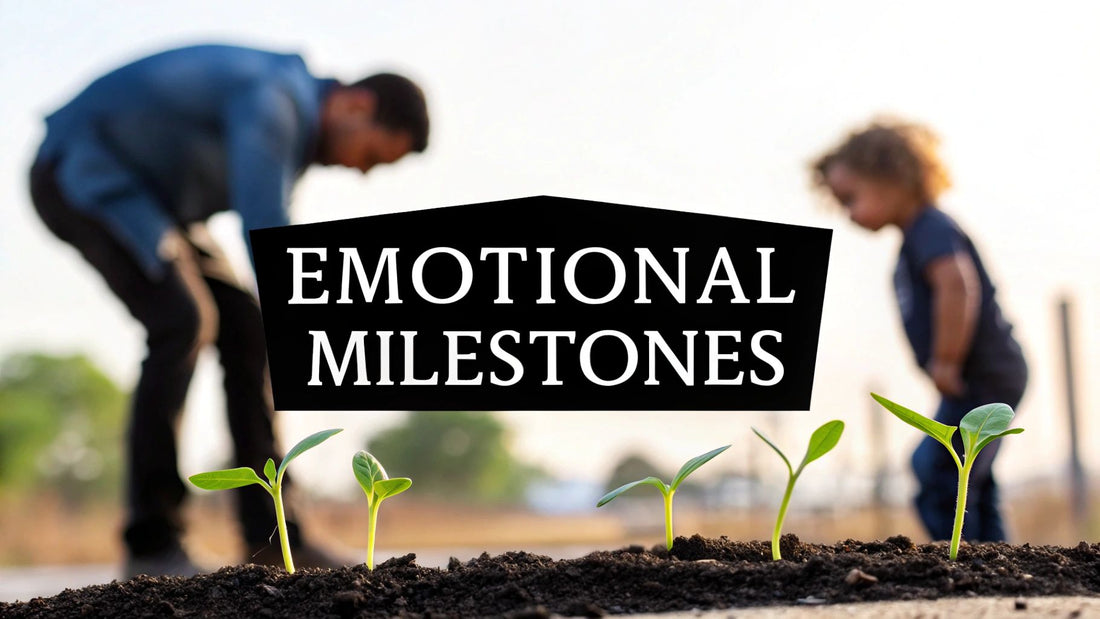
A Parent's Guide to Emotional Development Milestones
Share
Emotional development milestones are the little steps our children take on their big journey to understanding, showing, and managing their feelings. Think of them as signposts, guiding them from a baby’s very first smile to a teenager finally getting the hang of tricky social situations. Knowing what these stages look like helps you give them the right support when they need it most.
Why Understanding Emotional Milestones Matters
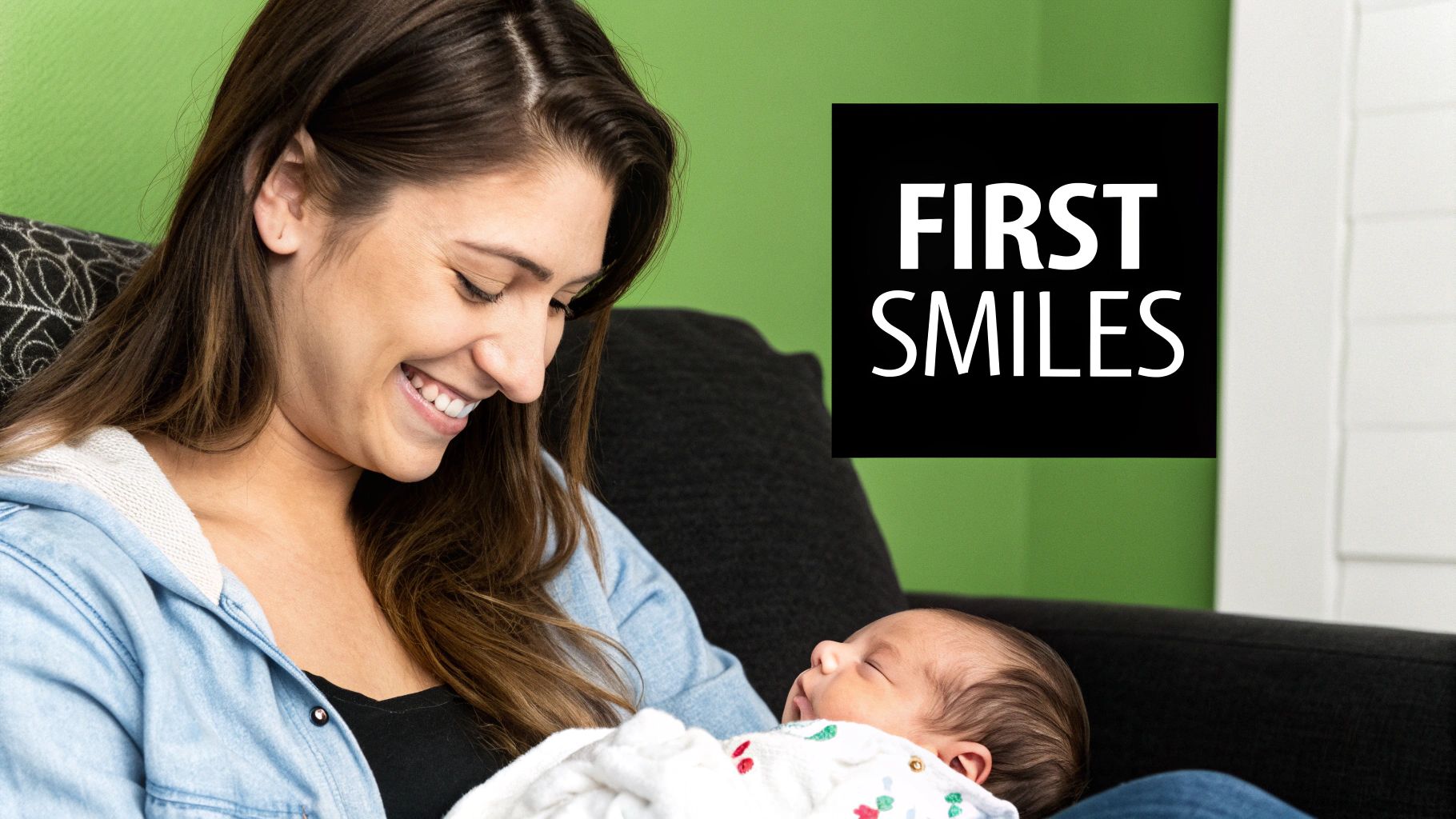
Helping your child navigate their emotional world can feel like a huge responsibility. But it’s not a race to a finish line; it’s a journey of connection. I like to think of it as tending to a garden – each stage of growth needs different care to build a strong, resilient foundation for a happy, healthy life.
Recognising these milestones is so important. It's a sobering thought that in the UK, one in six children aged 5-16 are identified as having a probable mental health problem. This really brings home why fostering emotional skills from the very beginning matters so much.
Please remember, this guide is for informational purposes only. I am not a mental health professional. If you have any concerns about your child's development, it is essential to consult a GP, health visitor, or a qualified professional for guidance. Trust your instincts—early support makes all the difference.
The Wider Impact of Childhood Emotional Health
A child's emotional wellbeing creates ripples that spread far beyond the family home. When a child's mental health needs aren't met, the long-term cost to UK businesses can be massive, estimated to be billions annually due to things like reduced productivity and greater strain on healthcare in adulthood. This makes supporting our children's emotional development not just a job for parents, but something that benefits all of us.
In our modern world, pressures like social media can make this journey even more complicated, often creating a landscape of comparison that can chip away at a young person's self-worth. Understanding emotional development helps you give your child the tools and resilience to face these challenges head-on.
To support this journey, many parents find real value in resources that normalise feelings. This can include:
- Mental Health Books: Stories that help children put a name to big, complex emotions.
- Mental Health Apparel: Clothing with positive affirmations that can spark conversations about feelings in an open and easy way.
- Relaxation Techniques: Simple practices like deep "belly breathing" or creating a calm-down corner can give children practical tools to manage stress.
This guide will walk you through a clear, age-by-age breakdown of emotional development milestones, helping you feel more confident as you support your child's emotional growth.
The First Big Feelings From Birth to Age 3
The journey into the world of emotions starts the moment a child is born. Those first three years are a whirlwind of change, transforming a newborn who only reacts to comfort or discomfort into a complex little person with a rich—and sometimes completely overwhelming—inner life. Getting to grips with these early emotional development milestones is one of the best ways to nurture a secure and resilient child.
Think of this early period as the time when the essential wiring for emotional intelligence is laid down. Every single interaction, from a soothing cuddle when they're upset to a shared giggle over a silly face, helps your baby understand they are safe, loved, and can count on you. This secure attachment is the bedrock for all their future emotional growth.
From Newborn Cries to Social Smiles (Birth to 12 Months)
In the first six months, a baby’s emotional toolkit is simple but incredibly effective. Crying is their main way of telling you they’re hungry, tired, or need a change, while those sweet coos and gurgles are clear signs of contentment. But the real magic happens at around two months with the arrival of the social smile—that first deliberate, joyful grin in response to your face or voice. It's a game-changer and one of the earliest true emotional milestones, marking the beginning of a real two-way connection.
As they crawl towards their first birthday, their emotional world explodes. They start showing obvious preferences for familiar faces and might suddenly burst into tears when a parent leaves the room. This is separation anxiety, and while it can be heartbreaking, it's actually a fantastic sign of a strong, healthy attachment. They're learning that you are their safe person. They also become experts at reading your face, looking to you for cues on how to feel in new situations.
The Toddler Years: Exploring Independence (1 to 2 Years)
The second year is all about a dawning sense of self. Your toddler is just starting to realise they are a separate person from you, and this discovery comes with a powerful urge for independence. This is what fuels the classic toddler "no!" phase as they test out their newfound autonomy.
During this time, their feelings become much bigger and bolder. Joy, anger, and fear are expressed with full-body commitment, but they have almost no ability to control these huge emotions. A tantrum isn’t your toddler being defiant; it's a raw, unfiltered explosion of frustration from a little person whose wants and needs are way more advanced than their ability to talk about them.
This is a crucial time for helping children learn the language of emotions. Simply naming what you see—"You seem so frustrated that the block tower fell down"—helps them connect a word to the powerful feeling inside them.
One brilliant way to support this is through stories. Reading together is a fantastic opportunity to explore feelings in a safe, relatable way. You can check out our recommended books about feelings for toddlers to find stories that will help open up these important conversations.
Developing Empathy and Self-Control (2 to 3 Years)
Between two and three, a toddler's emotional world gets even more nuanced. You’ll start to see the first beautiful glimmers of empathy—maybe they’ll offer a hug or their favourite teddy to a friend who is crying. This shows they are beginning to recognise and respond to the feelings of others, which is a monumental leap in their social and emotional journey.
They also start to experience a wider range of self-conscious emotions like pride, embarrassment, and shame. Praising their effort ("You worked so hard on that drawing!") rather than just the final product helps build a healthy sense of pride and self-worth. It's during this period that the very first foundations for emotional regulation are laid, as they slowly start to learn simple coping strategies with your patient guidance.
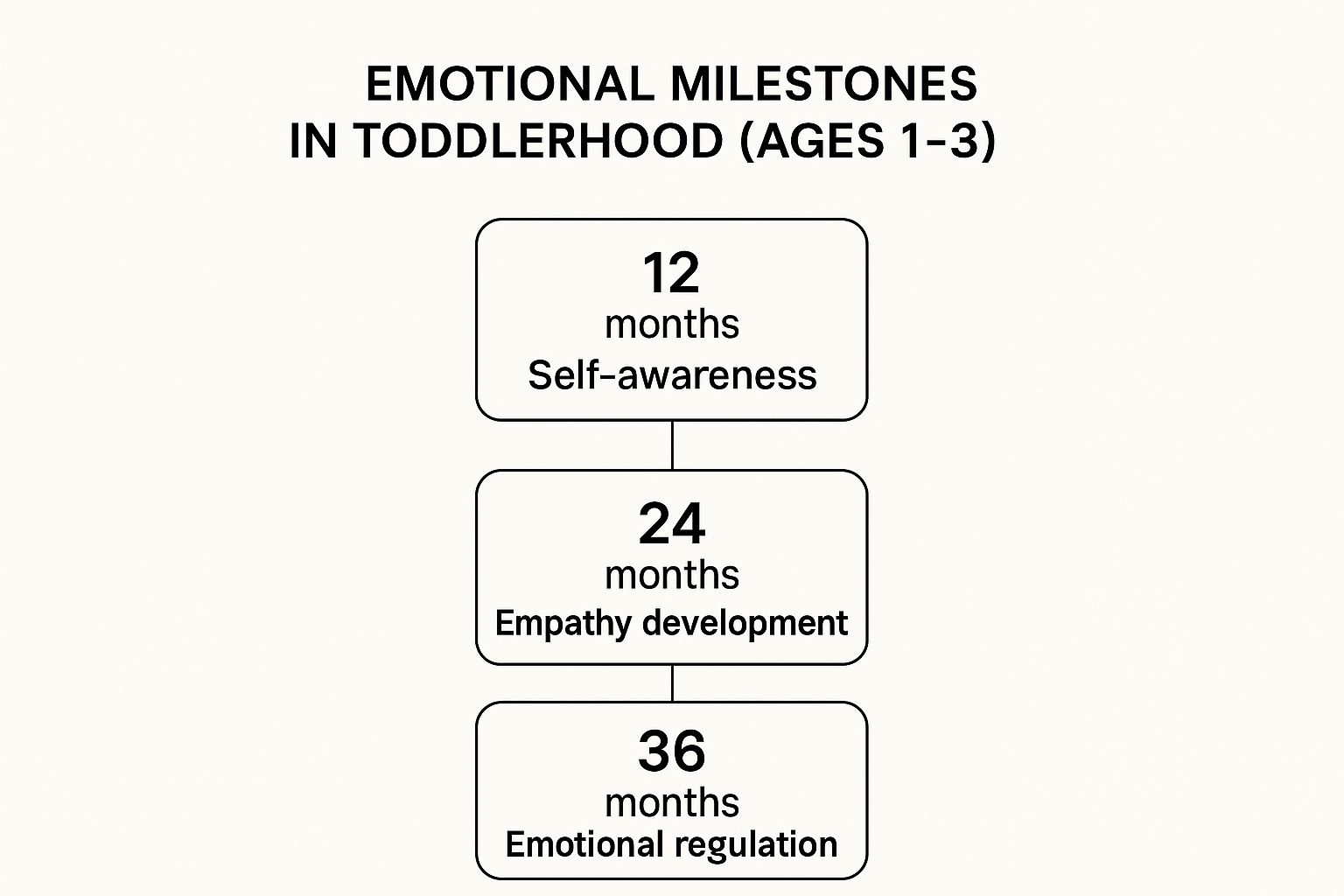
To make this easier to digest, here's a quick look at these milestones and how you can support your child through each stage.
Emotional Milestones and Support Strategies for Ages 0-3
| Age Range | Typical Emotional Milestone | How You Can Help |
|---|---|---|
| 0-6 Months | Uses crying to communicate needs. Begins social smiling (around 2 months). | Respond promptly and lovingly to their cries. Smile, talk, and make eye contact often. |
| 6-12 Months | Shows clear attachment to caregivers. Experiences separation anxiety. | Offer lots of cuddles and reassurance. Play peek-a-boo to help them understand object permanence. |
| 1-2 Years | Expresses a wide range of intense emotions (joy, anger, frustration). | Stay calm during tantrums. Help them label their feelings: "You are feeling angry." |
| 2-3 Years | Starts to show empathy for others. Develops self-conscious emotions like pride. | Model empathetic behaviour. Praise their efforts and good choices to build self-esteem. |
Following these small, consistent strategies helps build a strong emotional foundation, setting them up for a future of healthy relationships and resilience.
Building Empathy in the Preschool Years (Ages 4 to 7)
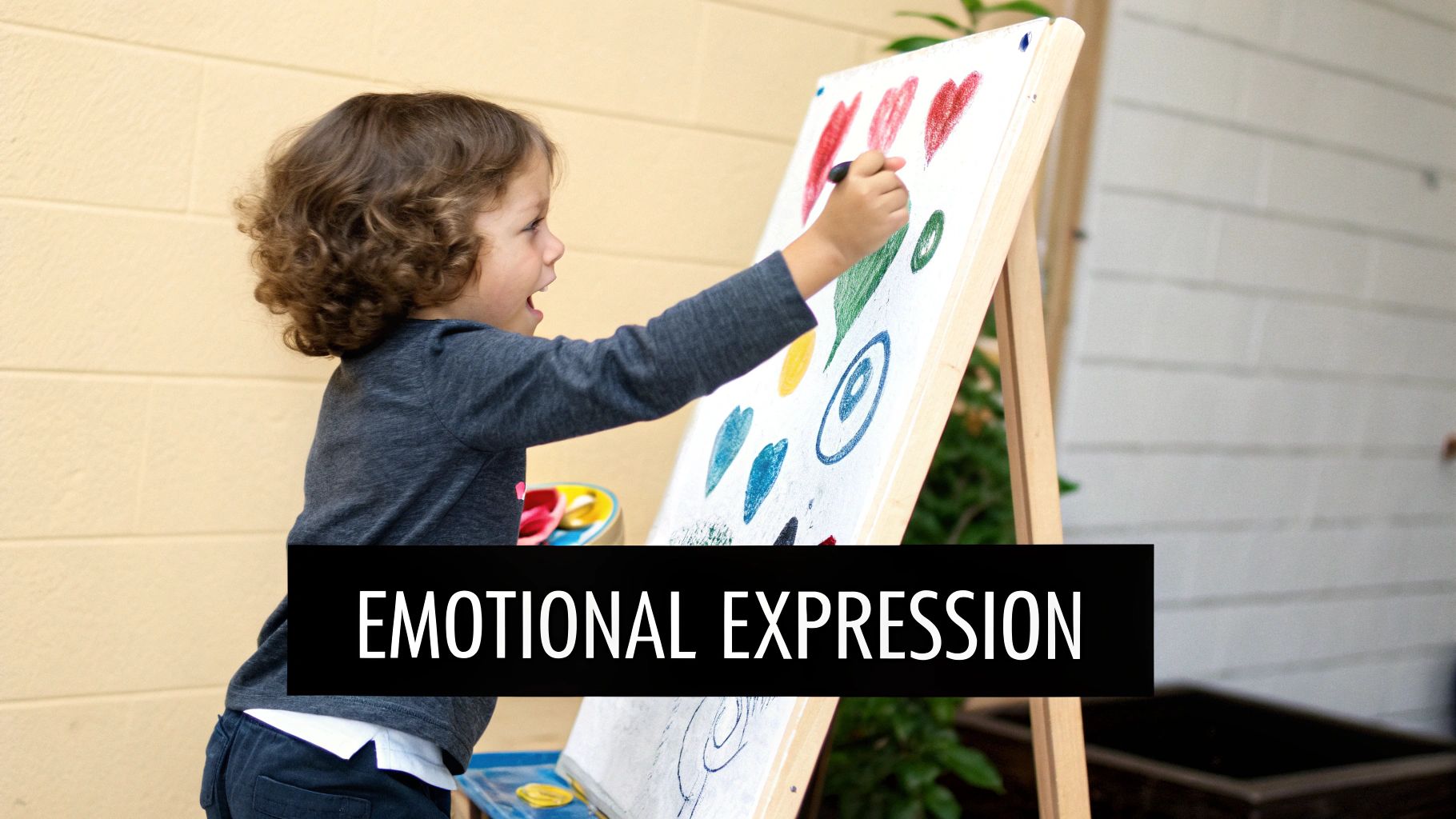
As children wave goodbye to the toddler years and step into the lively world of preschool and early primary school, their emotional lives get a whole lot more interesting. This period, from roughly ages four to seven, is an explosion of social growth. They’re moving from playing alongside friends to actually playing with them, and true friendships start to form, built on playground secrets and shared games.
This is the age where empathy really begins to sink its roots. A four-year-old might rush to offer a hug to a classmate who’s taken a tumble, not because a grown-up told them to, but because they genuinely see their friend is upset. These moments are huge emotional development milestones; they’re little signs that your child is starting to see the world from someone else’s point of view.
Understanding Social Rules and Big Feelings
Between four and five, children become acutely aware of social expectations. They start to grasp ideas like sharing and taking turns, even if they still find them a bit tricky in practice. Their desire to be liked and to please their friends becomes a huge motivator for their behaviour. You'll also hear a much richer emotional vocabulary emerge, with words like "worried," "excited," or "disappointed" popping up more often.
But their ability to manage these big new feelings is still very much under construction. A five-year-old might lash out in frustration during a game they're losing. It’s not because they're being "naughty," but because the sheer weight of that disappointment feels too much to handle. This is a completely normal part of their journey towards self-regulation.
As they edge closer to six and seven, their friendships tend to become more stable, and they get better at navigating social situations. They can follow more complicated rules in games and are more likely to negotiate with their friends when disagreements pop up. A stronger sense of right and wrong also develops, and they often become passionate champions for fairness on the playground.
At this stage, it's so important to remember that their emotional control is a work in progress. They need our patient guidance to learn how to express frustration or anger constructively, rather than just hitting or shouting.
This developmental stage is closely monitored here in the UK, as emotional and social skills are key parts of child health reviews. For instance, data from Public Health Scotland's 4-5 year review shows that 8% of children had concerns noted about their emotional or behavioural development. This just highlights that roughly 1 in 12 children might need a bit of extra support as they start school. You can read the full child development statistics for more detail on these findings.
Practical Ways to Nurture Empathy and Emotional Skills
Supporting your child through these emotional development milestones isn't really about formal lessons. It’s all about the small, everyday interactions that provide the blueprint for how they respond to their own emotions.
- Talk About Feelings in Stories: When you’re reading together, hit pause and chat about the characters. Ask things like, "How do you think the wolf felt when the pigs outsmarted him?" or "Why was the princess so happy at the end?" This builds their emotional library and helps them connect feelings to actions.
- Name Their Emotions (and Yours): Help your child put a name to what they're feeling. You could say, "It looks like you're feeling really frustrated with that puzzle." You can also model it yourself: "I'm feeling a bit tired today, so I'm going to rest for a few minutes."
- Role-Play Social Scenarios: Use their dolls or action figures to act out common social challenges. You could practise asking to join a game, sharing a favourite toy, or what it feels like to say sorry. It gives them a safe space to rehearse these important skills.
Navigating Common Challenges
Even with all the support in the world, this age comes with its own set of hurdles. Shyness, jealousy over a best friend, or the occasional aggressive outburst are all common as kids try to figure out their place in their social world. When these moments happen, try to see them as learning opportunities rather than behaviour problems.
Instead of simply telling a child off for not sharing, try validating their feeling first. "I know you really love that car and wanted to keep playing with it. It's so hard to wait for your turn." Then, you can gently guide them towards a solution: "How about you play for five more minutes, and then we'll let your brother have a go?"
By offering this calm, consistent support, you are actively helping your child build the foundations for lifelong emotional resilience. For a deeper dive, you can also explore our guide on teaching emotional awareness to children and the importance of fostering empathy.
How to Spot When Your Child Needs More Support
It’s one of the biggest worries that keeps parents up at night: ‘Is my child’s behaviour typical, or is there something more going on?’ Every child hits their emotional milestones on their own unique schedule, but sometimes you might notice patterns that suggest they could use a little extra support. Your intuition as a parent is one of the most powerful tools you have.
Spotting these signs isn’t about jumping to conclusions or sticking a label on your child. Think of it more as recognising a quiet request for help. These are just clues that your child might be struggling to handle their big feelings or find their way in their social world, and that a chat with a professional could make a world of difference.
Recognising Red Flags Across Different Ages
While a bit of variation in development is completely normal, persistent struggles in certain areas might need a closer look. We’re not talking about a single bad day or a grumpy week, but a consistent pattern of behaviour that you see over time.
Here are a few examples of what this might look like at different stages:
- For Toddlers (1-3 years): You might notice a toddler who consistently shows very little interest in interacting with their main caregivers, regularly avoids eye contact, or doesn’t look for comfort when they’re hurt or upset.
- For Preschoolers (4-5 years): This could be a child who is always withdrawn from their friends, has extreme separation anxiety that disrupts daily life, or has frequent, uncontrollable aggressive outbursts that just don’t match the situation.
- For School-Aged Children (6+ years): This might be a child struggling with overwhelming and constant anxiety, a sudden and lasting drop in their school performance, or a complete withdrawal from friends and hobbies they used to love.
If you’re seeing persistent or severe emotional distress, it can be really helpful to learn more about understanding common anxiety disorders. This knowledge can give you the confidence to have more informed conversations with professionals.
The Importance of Early Intervention
It turns out that parental concern is a huge factor in identifying children who might need a bit of help. A 2022 UNICEF UK report found that 42% of parents with children aged 0-4 worried about their child's social or emotional wellbeing. This just goes to show how tuned-in parents are to these vital early years and that if you’re worried, you are definitely not alone.
Getting on top of these challenges early can genuinely change a child’s path in life. Early support helps children build coping skills, develop healthier ways to manage their emotions, and improve their friendships before tricky patterns become too ingrained. It gives them the tools they need to flourish.
The goal of seeking support isn't to ‘fix’ a problem. It’s about giving your child the scaffolding they need to continue their emotional growth. It is a proactive, loving step towards looking after their long-term mental wellbeing.
Who to Talk To If You Are Worried
If your gut is telling you that something isn't right, please listen to it. You are the expert on your child. The great news is there are plenty of approachable, supportive professionals in the UK who can offer guidance.
Your first points of call could be:
- Your Health Visitor: They are experts in child development and can offer reassurance, advice, and referrals if they think they’re needed.
- Your GP: A General Practitioner can look at your child's overall health and connect you with specialised services like Child and Adolescent Mental Health Services (CAMHS).
- The School's SENCO: The Special Educational Needs Coordinator at your child's school or nursery is a fantastic person to talk to about any social or emotional struggles they might be having there.
Taking that first step can feel huge, but it's a powerful way to advocate for your child's mental health. To feel a bit more prepared for these conversations, it can be helpful to get a feel for the principles of providing initial support. You might find our guide on what is involved in Youth Mental Health First Aid useful.
Modern Pressures on Your Child's Emotional Health
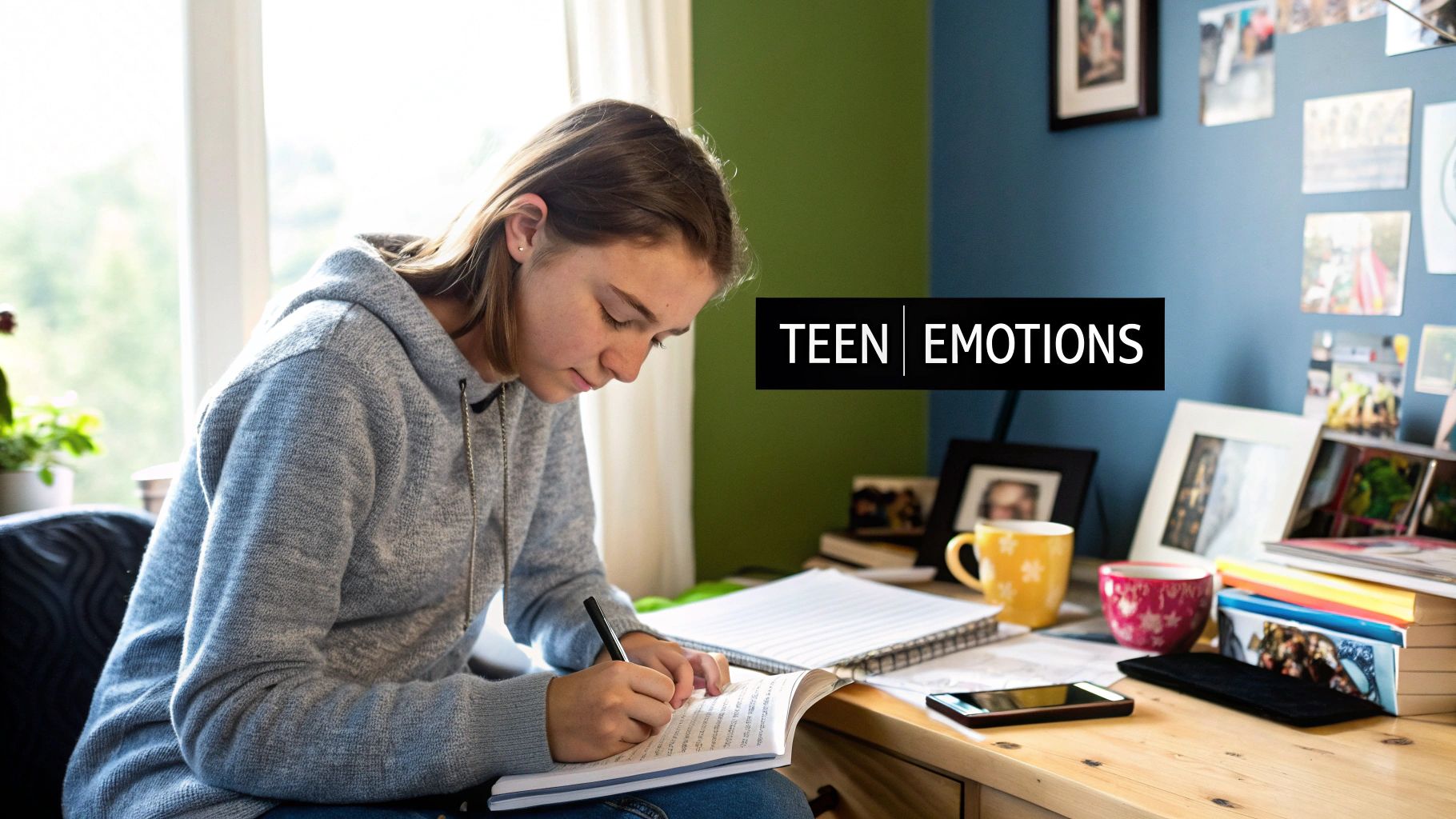
Today’s kids are growing up in a world that looks vastly different to the one we knew. While the core emotional milestones haven't changed, the environment they're navigating is packed with unique and complex pressures that can throw their mental wellbeing off balance. Getting to grips with these modern challenges is the first step in helping them build true resilience.
One of the biggest culprits we all talk about is the ever-present screen. From tablets to smartphones, digital devices are tangled up in our daily lives, but too much unsupervised use can stunt emotional growth. It simply steals time away from crucial face-to-face interactions, where children learn the subtle art of reading social cues and flexing their empathy muscles.
The Impact of Social Media and Comparison
For older kids and teens, social media adds a powerful and often painful dynamic into the mix. It can become a relentless source of social comparison, where the curated, filtered versions of everyone else's life create totally unrealistic expectations. This can slowly chip away at self-esteem, feeding a constant anxiety about not being popular, successful, or happy enough.
This pressure to perform isn’t just an online phenomenon. The modern education system, with its intense focus on testing and achievement, can also place a huge amount of stress on young minds. This high-stakes environment, coupled with social pressures, creates a tough landscape for a child’s developing emotional regulation skills.
Modern family setups can also bring their own unique stressors. For parents dealing with particularly tough dynamics, understanding strategies for high-conflict co-parenting is absolutely vital for minimising the emotional fallout for the children involved.
The Broader Cost of Neglecting Children's Mental Health
Tackling these issues isn't just a family affair; it's a societal necessity. The long-term consequences of leaving childhood mental health problems unaddressed are massive. Research shows that poor mental health in childhood is directly linked to reduced productivity and greater healthcare needs in adulthood, costing UK businesses billions of pounds every single year.
Investing in a child's emotional health is one of the most effective forms of preventative care for our future communities and economy. It underscores the importance of creating supportive environments at home and in school.
This really brings home why fostering emotional resilience from a young age is so critical. By setting healthy boundaries around technology, encouraging open conversations, and pushing for more nurturing educational environments, we empower our children. We give them the tools to not just cope with modern pressures, but to truly thrive in spite of them.
Your Practical Toolkit for Nurturing Wellbeing
Supporting your child on their emotional journey is all about connection and conversation. Having a few practical, everyday tools up your sleeve can make a world of difference, turning those overwhelming moments into chances to grow and understand each other better. This little toolkit is designed to give you some simple, effective strategies you can start using today.
The reality of children's mental health in the UK is something we can't ignore. With one in five children now having a probable mental health disorder, actively nurturing their wellbeing from a young age isn't just a nice-to-have; it's essential.
Simple Relaxation Tips for Big Feelings
When big feelings take over, simple physical actions can work wonders to calm a child's nervous system. These techniques are brilliant because they give kids a sense of control over their own bodies and emotions.
- Belly Breathing: Ask your child to pop a hand on their tummy and imagine it's a balloon. They breathe in slowly through their nose to make the balloon bigger, and then breathe out slowly through their mouth to let all the air out. It's a game-changer.
- Create a Calm-Down Corner: Find a cosy, quiet spot in your home and fill it with soft cushions, sensory toys, and maybe a favourite blanket. This isn't a "naughty step" or a time-out spot. It’s a safe retreat they can choose to use whenever they feel overwhelmed.
Opening Conversations Through Books and Apparel
Sometimes, just starting a chat about feelings is the hardest part. Using things like books or even clothing can make it feel much more natural and less daunting for everyone involved.
Mental health books are a fantastic way in. Stories with characters who are navigating sadness, anger, or worry help to show your child that these feelings are completely normal. Cuddling up with a book together creates a safe space to ask questions and link the story back to their own experiences.
Another creative idea is to use mental health apparel. A t-shirt or hoodie with a gentle message like "It's Okay To Not Be Okay" can be a simple, everyday reminder that it's good to talk. It’s a subtle way to open up a dialogue and show that mental health is something we can discuss openly, without any shame.
Disclaimer: It’s really important to remember that I'm not a mental health professional. The tips and resources I'm sharing here are for informational purposes. If you are worried about your child's mental or emotional wellbeing, please chat with your GP or a qualified healthcare provider.
The ripple effect of unaddressed mental health issues is huge, with poor mental health costing UK businesses up to £56 billion a year. By using these simple tools, you're not only supporting your own child but also helping to build a healthier, more emotionally literate future generation. These small, consistent efforts lay a powerful foundation for lifelong wellbeing.
Got Questions? We’ve Got Answers.
As you get to grips with your child's emotional world, it's completely normal for questions to pop up. Let's walk through some of the most common ones parents ask.
How Can I Tell the Difference Between a Toddler Tantrum and a Serious Issue?
This is a big one, and something nearly every parent of a toddler has wondered about. Honestly, the key difference usually comes down to the frequency, intensity, and duration of the meltdown.
A classic toddler tantrum is usually a short, sharp explosion of frustration. It’s often triggered by something specific (like wanting a biscuit right now) and tends to fizzle out once they're distracted or the situation is resolved. For example, a two-year-old might throw themselves on the floor because they can't have another ice lolly, but five minutes later they're happily playing with a toy car.
But if the tantrums feel relentless, are incredibly intense for long stretches, involve self-harm, or your little one seems totally unable to recover, it might be a sign of something more. The best advice? Trust your gut. If the behaviour feels consistently extreme and is starting to really impact family life, it’s always worth a chat with a health visitor or your GP.
My Child Seems Much Shier Than Their Peers. Should I Be Worried?
It’s easy to compare our kids to others, but shyness is a very common personality trait, not automatically a red flag. Lots of children are naturally more reserved and just need a bit more time to feel comfortable in new situations or around new people.
The important thing to watch for is whether their shyness is causing them real distress or stopping them from doing things they'd otherwise love to do. For instance, it's one thing for a child to cling to your leg for ten minutes at a party, but it's another if they are so fearful they refuse to go to school or see their friends.
If their shyness seems tied to intense anxiety, if they avoid all social contact, or if it appears very suddenly after a stressful event, that's when it might be a good idea to seek some professional advice. Otherwise, the best approach is to gently encourage them without pushing, and give them the space and time they need to warm up at their own pace.
What Are Some Simple Daily Activities to Boost Emotional Intelligence?
Building emotional intelligence doesn't mean you need to schedule in complicated lessons or activities. It’s all about weaving it into the small, everyday moments you already share.
- Name That Feeling: Get into the habit of labelling emotions – both theirs and yours. Saying things like, "I can see you're feeling really frustrated with that puzzle," or "I'm feeling so happy we're going to the park today!" makes feelings a normal part of conversation.
- Play the 'I wonder' Game: When you're reading a book or watching a show together, pause and ask, "I wonder how that character is feeling right now?" It’s a brilliant, low-pressure way to encourage them to think about other people’s perspectives.
- Do a Daily Check-in: Make it a routine to ask about the "highs and lows" of their day. This simple chat creates a safe space where they know it's okay to talk about both the good stuff and the tricky feelings.
Where in the UK Can I Find Reliable Help for My Child?
If you have concerns about your child's emotional development, please know you are not alone, and there is fantastic support out there. It can feel daunting to know where to start, so here are a few reliable first steps:
- Your GP or Health Visitor: They should always be your first port of call. They can listen to your concerns, assess your child's needs, and refer you to more specialised services like CAMHS (Child and Adolescent Mental Health Services) if needed.
- YoungMinds: This is a leading UK charity dedicated to children's mental health. Their website is packed with resources, and they run a parents' helpline that offers wonderful advice and support.
- The School: Don't hesitate to speak to your child's teacher or the school's Special Educational Needs Coordinator (SENCO). They see your child in a different environment and can often provide support within the school setting.
Remember, reaching out for help is a sign of strength. It's the best thing you can do for your child's long-term wellbeing.
At That's Okay, we believe in nurturing emotional literacy right from the start. We invite you to explore our collection of mental health books, supportive mental health apparel, activities, and resources, all designed to help you and your child navigate the world of feelings together. Visit us at https://thatsokay.co.uk to find the perfect tools for your family's journey.
